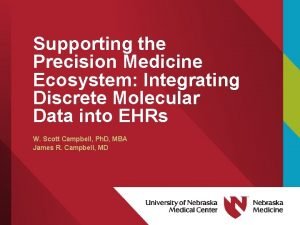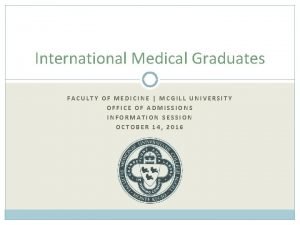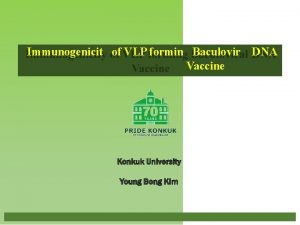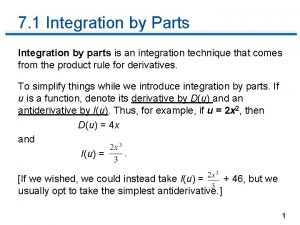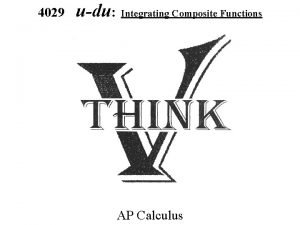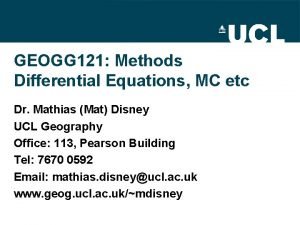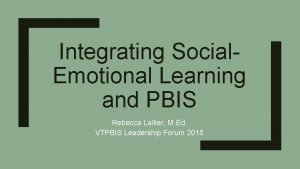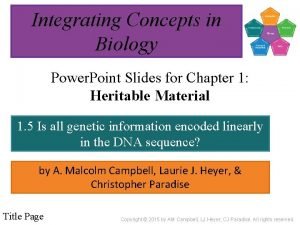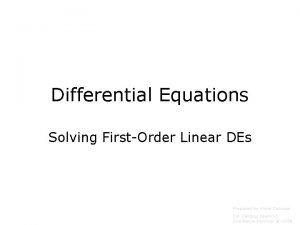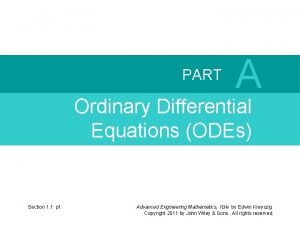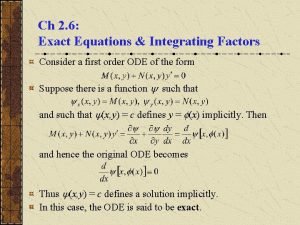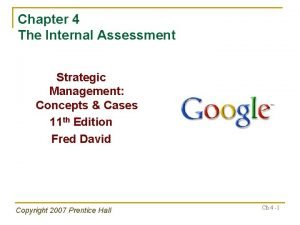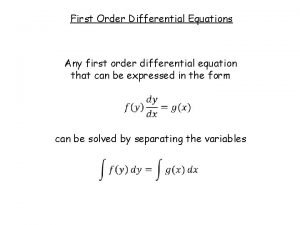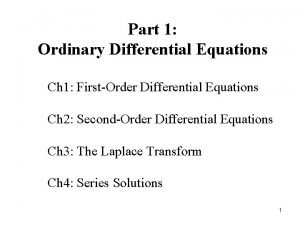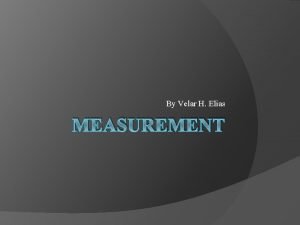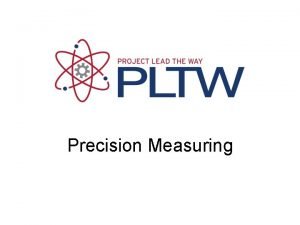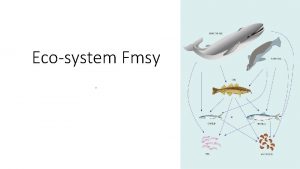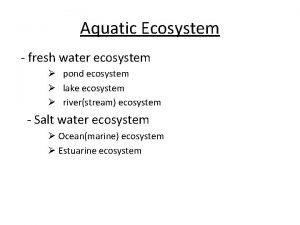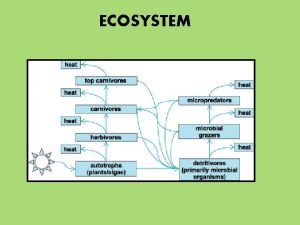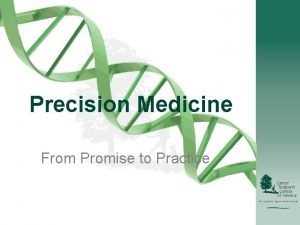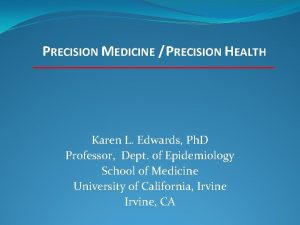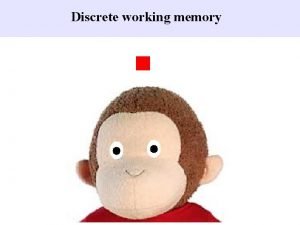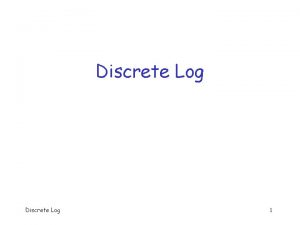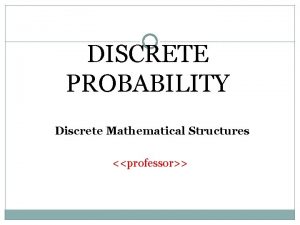Supporting the Precision Medicine Ecosystem Integrating Discrete Molecular








































- Slides: 40

Supporting the Precision Medicine Ecosystem: Integrating Discrete Molecular Data into EHRs W. Scott Campbell, Ph. D, MBA James R. Campbell, MD

Acknowledgements • College of American Pathologists –Raj Dash, MD; Alexis Carter, MD; Mark Routbort , MD Ph. D; Mary Kennedy; Monica de Baca, M; Sam Spencer, MD • UNMC - Allison Cushman-Vokoun, MD Ph. D, Tim Griener, MD • Swedish Board of Health, Sweden - Daniel Karlsson, Ph. D • Royal College of Pathologists and e. Digital Health (NHS) – Deborah Drake, Laszlo Iglali, MBBS • SNOMED International Observable Project –Farzaneh Ashrafi, Ian Green • Regenstrief Institute Inc. – Daniel Vreeman, DPT, Swapna Abhyankar, MD • International Collaboration on Cancer Reporting – David Ellis, MD; John Srigley, MD Dr. W. Scott Campbell and Dr. James R. Campbell partially supported by NIH Award: 1 U 01 HG 00945502; Patient Centered Outcomes Research Institute (PCORI) Award CDRN-1306 -04631); Funding from UNMC Departments of Pathology and Microbiology and Internal Medicine

Begin with the end in mind • Render pathology data to computable forms for patient care at the point of care • Render genomics data to computable form for use at the point of care for patient care • Capture data in pathology and genomics at the point of care to support new discovery at the bench • Bring bench discovery back to the point of care to support patient care It is about the patient and aiding the patient and care team to make informed decisions

Multiple Use Cases Cancer treatment planning Precision medicine research project planning Laboratory risk and safety management Retrieving biobank tissue for research protocols

Examples Cancer treatment planning: • Colon cancer (Stage IV or metastatic), testing for BRAF, *RAS, MSI, and use of BRAF, EGFR or immunologic therapy by protocol/not by protocol…Outcome? Research Project Planning: • How many healthy patients do we have that are BRCA 1 or BRCA 2 positive • Retrieve all breast cancer cases that tested ER-, PR- and Her 2/neu Medical-legal, compliance and safety: • Recall of all cancer cases for treatment review with (formerly thought insignificant) somatic gene sequence variant reported • CAP accreditation requirements for molecular laboratories. Tissue Biobank Applications: • Find all malignant neoplasms of any origin tested for BRAF mutation AND reported positive for lymphatic metastases. What is needed to meet the needs of these researchers and clinicians is a domain ontology (structured, defined coding hierarchy) which we can query for detailed results These data types are called “Observables”

Terminology Implementation Requirements • Conform to the current EHR ecosystem • Incorporation into natural workflows of providers • Upstream systems • Point of care • Non-intrusive • Support primary and secondary uses of data

EHR Technology • What it is: • Patient-centric • Encounter based • Longitudinal Medical Record • Transactional • Billing orientation • What it can be: • Integrated patient-centric data • Basis for clinical decision support • Population management • Requirements (Just a few…) • Standards • Standard use of standards • System Integration/Interoperability

Histopathology Reporting Evolution Basic Level 1 - Narrative Advanced Level 2 – Narrative with required data elements Level 3 – Narrative with required data elements in Synoptic format Level 4 – Level 3 plus electronic user interface for data entry Level 5 – Level 4 plus structured language and discrete data capture 1. Srigley JR, Mc. Gowan T, Maclean A, Raby M, Ross J, Kramer S, et al. Standardized synoptic cancer pathology reporting: a population-based approach. J Surg Oncol. 2009 Jun 15; 99(8): 517 -24. Level 6 – Level 5 plus all data encoded in machine readable, standard terminology Level 7 Semantic interoperabi lity

AP Example: Microscopic local invasion of colon tumor

Example Value set Direct extension of colon tumor Value set of answers 1220001000004105 |Status of microscopic invasion of excised colon malignant neoplasm (observable entity)| Tumor invasion cannot 87100004 | Topography unknown be assessed (body structure) | No evidence of primary 21229009 | Topography not assigned tumor (body structure) | Carcinoma in situ, 42978003 | Colonic epithelium (body intraepithelial structure) | Carcinoma in situ, 113284008 | Colonic lamina propria invasion of lamina (body structure) | propria Tumor invades 61647009 | Colonic submucosa (body submucosa structure) | Tumor invades 41948009 | Colonic muscularis propria structure (body structure) | Tumor invades through the muscularis propria into the subserosa or 52010009 | Colonic subserosa (body into non-peritonealized structure) | pericolic or perirectal tissue Tumor penetrates 90132000 | Colonic serosa (body serosa structure) |

Implementation - Terms Bound to Co. Path® for Pathologist

Resultant Report (w/ IHC)

Co. Path® Structured AP Synoptic Reports MSH|^~&|COPATH|EPIC||2017 NNNN||ORU^R 01||P|2. 3. 1 PID|1||2529400||NAME^^^||1968 NNNN|M||W|ADDRESS|| PV 1|1||3 BE|||||||^NAME||TCE OBR|1||SNN-NNNN^Co. Path. Plus|EXAM^EXAM|||||A|^RIGHT COLON|NNNNNN|||||F OBX|2|CWE|721754191000004103^Colon-Margins: Distal^SCT||369708000^Distal margin uninvolved by invasive carcinoma^SCT||||||F OBX|3|CWE|200661231000004105^Colon-Specimen(s) included in case^ SCT||32713005^Cecum^SCT||||||F OBX|4|CWE|661259881000004105^Cancer Treatment Effect^SCT||997170731000004106^No prior treatment^SCT||||||F OBX|5|CWE|669509521000004104^Cancer Perineural Invasion^SCT||370051000^Perineural invasion absent^SCT||||||F OBX|6|CWE|384625004^Primary Tumor (p. T) Category^SCT||395707006^p. T 3: Tumor invades through the muscularis propria into pericolorectal tissues^SCT||||||F OBX|7|CWE|371497001^Colon-Distant Metastasis (p. M)^SCT||17076002^p. MX: Cannot be assessed^SCT||||||F OBX|9|CWE|200661231000004105^Colon-Specimen(s) included in case^SCT||66754008^Appendix^SCT||||||F OBX|10|CWE|200661231000004105^Colon-Specimen(s) included in case^SCT||9040008^Ascending colon^SCT||||||F

Genomics: Who anticipated this? ##fileformat=VCFv 4. 1 ##file. Date=20140305 ##vcfversion=1. 2 ##vcf. Process. Log=<Input. VCF=file 1. vcf, Input. VCFSource=caller 1, Input. VCFVer=1. 0, Input. VCFParam=a 1, b, Input. VCFgene. Anno=anno 1. gaf> ##reference=ftp: //ftp. ncbi. nih. gov/genbank/genomes/Eukaryotes/vertebrates_mammals/Homo_sapiens/GRCh 37/special_requests/GRCh 37 -lite. fa ##contig=<ID=20, length=62435964, assembly=B 36, md 5=f 126 cdf 8 a 6 e 0 c 7 f 379 d 618 ff 66 beb 2 da, species="Homo sapiens", taxonomy=x> ##phasing=partial ##INFO=<ID=NS, Number=1, Type=Integer, Description="Number of Samples With Data"> ##INFO=<ID=DP, Number=1, Type=Integer, Description="Total Depth"> ##INFO=<ID=AF, Number=A, Type=Float, Description="Allele Frequency"> ##INFO=<ID=AA, Number=1, Type=String, Description="Ancestral Allele"> ##INFO=<ID=DB, Number=0, Type=Flag, Description="db. SNP membership, build 129"> ##INFO=<ID=H 2, Number=0, Type=Flag, Description="Hap. Map 2 membership"> ##FILTER=<ID=q 10, Description="Quality below 10"> ##FILTER=<ID=s 50, Description="Less than 50% of samples have data"> ##FORMAT=<ID=GT, Number=1, Type=String, Description="Genotype"> ##FORMAT=<ID=GQ, Number=1, Type=Integer, Description="Genotype Quality"> ##FORMAT=<ID=DP, Number=1, Type=Integer, Description="Read Depth"> ##FORMAT=<ID=HQ, Number=2, Type=Integer, Description="Haplotype Quality"> ##SAMPLE=<ID=NORMAL, Individual=TCGA-01 -1000, File=TCGA-01 -1000 -1. bam, Platform=Illumina, Source=db. GAP, Accession=1234> ##SAMPLE=<ID=TUMOR, Individual=TCGA-01 -1000, File=TCGA-01 -1000 -2. bam, Platform=Illumina, Source=db. GAP, Accession=4567> ##PEDIGREE=<Name_0=TUMOR, Name_1=NORMAL> #CHROM POS ID REF ALT QUAL FILTER INFO FORMAT NORMAL TUMOR 20 14370 rs 6054257 G A 29 PASS NS=3; DP=14; AF=0. 5; DB; H 2 GT: GQ: DP: HQ 0|0: 48: 1: 51, 51 1|0: 48: 8: 51, 51 20 17330 . T A 3 q 10 NS=3; DP=11; AF=0. 017 GT: GQ: DP: HQ 0|0: 49: 3: 58, 50 0|1: 3: 5: 65, 3 20 1110696 rs 6040355 A G, T 67 PASS NS=2; DP=10; AF=0. 333, 0. 667; DB GT: GQ: DP: HQ 1|2: 21: 6: 23, 27 2|1: 2: 0: 18, 2 20 1230237. T . 47 PASS NS=3; DP=13; AA=T GT: GQ: DP: HQ 0|0: 54: 7: 56, 60 0|0: 48: 4: 51, 51 20 1234567 microsat 1 GTC G, GTCTC 50 PASS NS=3; DP=9; AA=G GT: GQ: DP 0/1: 35: 4 0/2: 17: 2

Houston: We have a problem How to put a square peg into a round hole?

What to do with all this Data? Technical Desiderata for integration of genomic data into the EHR 1. Maintain separation of primary molecular observations from the clinical interpretations of those data 2. Support lossless compression from primary molecular observations to clinically manageable subsets 3. Maintain linkage of molecular observations to the laboratory methods used to generate them 4. Support compact representation of clinically actionable subsets for optimal performance 5. Simultaneously support human viewable formats and machine readable formats in order to facilitate implementation of decision support rules 6. Anticipate fundamental changes in the understanding of human molecular variation 7. Support both individual clinical care and discovery science 1. Masys DR, Jarvik GP, Abernethy NF, Anderson NR, Papanicolaou GJ, Paltoo DN, et al. Technical desiderata for the integration of genomic data into Electronic Health Records. J Biomed Inform. 2012 Jun; 45(3): 419 -22.

Molecular Pathology Data Flow Data Generation Data Analysis Specimen Pathologist Assessment Data Use and Storage Final Report Sequencing Raw Data BAM files VCF files Tissue type Tumor % Gene ID’s Reference Gene Knowledge bases EHR

Data Use – Data Generation Specimen Raw Data (i. e. , Primary Data) Necessary for clinical interpretation Sequencing Raw Data BAM files VCF files Tissue type Tumor % Gene ID’s Reference Gene Valuable to Research Community Value to consumers – clinicians, patients?

Data Use – Data Analysis Pathologists consider outputs of Data Generation step Access Knowledge Bases to reconcile data with current genomic understanding Render assessment of variants detected and should be reported Classify variants in terms of clinical significance

Data Use –Use and Storage Final report – pdf format Enumeration of variants detected classified by clinical significance Additional items: Type of alteration, Allele frequency (in population), availability of potential clinical trials Useful for individual clinical encounter but of limited value for extended clinical care, decision making and research.

More on the Final Report • Based on the specific gene variants detected and reported by the pathologist. • What elements are needed in the EHR in computable form? • One-to-one relationship of reported variants and their representation in the variant call file (VCF) • Can the VCF representation of the reported variants be used as discrete elements in the EHR?

Sample Molecular pathology report – VERY truncated

Terminology Approach KRAS Variant Detected How to represent the result?

Variant Call Format #CHROM POS ID REF ALT QUAL FILTER INFO FORMAT NORMAL TUMOR 20 14370 rs 6054257 G A 29 PASS NS=3; DP=14; AF=0. 5; DB; H 2 GT: GQ: DP: HQ 0|0: 48: 1: 51, 51 1|0: 48: 8: 51, 51 20 17330 . T A 3 q 10 NS=3; DP=11; AF=0. 017 GT: GQ: DP: HQ 0|0: 49: 3: 58, 50 0|1: 3: 5: 65, 3 20 1110696 rs 6040355 A G, T 67 PASS NS=2; DP=10; AF=0. 333, 0. 667; DB GT: GQ: DP: HQ 1|2: 21: 6: 23, 27 2|1: 2: 0: 18, 2 20 1230237. T . 47 PASS NS=3; DP=13; AA=T GT: GQ: DP: HQ 0|0: 54: 7: 56, 60 0|0: 48: 4: 51, 51 20 1234567 microsat 1 GTC G, GTCTC 50 PASS NS=3; DP=9; AA=G GT: GQ: DP 0/1: 35: 4 0/2: 17: 2 Important data Essential data for EHR? Discrete and computable Contains data that has limited value outside the context of the initial report Difficult to import and manage within EHR structures TOO COMPLICATED FOR EHR – Need something simple

Human Genome Variation Society Representation • Human Genome Variation Society (HGVS) • Standardized nomenclature for variants • Includes nomenclature for normal sequences Examples: Accession. version Coding change Amino Acid change BRAF V 600 E: NM_004333. 4: c. 1799 T>A(p. Val 600 Glu) BRAF normal: NM_004333. 4: c. (=) No coding change

HGVS in EHR and Biobank • HGVS representation of genetic information in EHR is tractable • Data is a structured string • Easily accommodated in EHR • Data easily queried by regular expression • Maintain links to curated gene knowledge bases • Standardized representation • Used by reference databases, knowledge bases • Applicable to targeted gene sequencing and whole genome sequencing • Retains clinically relevant and actionable information • Can be readily moved via HL 7

Genomic Data Flow and Store Data Generation Raw Data BAM files VCF files Tissue type Tumor % Gene ID’s Reference Gene Raw data stored in original form for research at point of creation Data Analysis Pathologist Assessment Data Use and Storage Final Report (pdf) EHR Final Report (HL 7) VCF data (reported and not reported) in VCF and HGVS form in biorepository Biobank Report (pdf) and HGVS data stored in EHR

Genomic Data Flow Example Data Analysis Pathologist Assessment Data Use and Storage EHR Final Report (HL 7) Biobank HL 7 Message Sent 1. Pathologist sign-out is the trigger event Final Report (pdf) 2. PDF report sent per usual practice 3. HL 7 version 2. 5. 1 message sent to biobank and EHR, simultaneously MSH|^~&|Genom. Oncology Workbench|UNMC|Mirth|UNMC|||ORU^R 01^ORU_R 01|77801|P|2. 5. 1| PID|1||12345||Doe^Jane^||19850206|F ORC|1||G 17 -xxx||CM||^^^^ OBR|1||G 17 -xxx|55232 -3^Genetic analysis summary panel^LN||| OBX|1|FT|51969 -4^Genetic analysis summary report^LN||<p>For this specific specimen there was 200 X coverage for the following regions, therefore low frequency variants in these regions may not be identified: three amplicons of CEBPA exon 1, CUX 1 exons 1, 19, and 23, and STAG 2 exon 7. Only clinical trials that pertain to genes with identified somatic mutations are reported. OBR|2||G 17 -xxx|55207 -5^Genetic analysis discrete result panel^LN||||||^Bruce Willis, MD OBX|1|CWE|911752541000004109^TP 53 sequence variant identified in excised malignant neoplasm (observable entity)^SCT|1|TP 53 NP_000537. 3: R 175 H NM_000546. 5: c. 524 G>A^TP 53 R 175 H|||Pathogenic|||F OBX|2|CWE|911752871000004102^ASXL 1 sequence variant identified in excised malignant neoplasm (observable entity)^SCT|1|ASXL 1 NP_056153. 2: N 986 S NM_015338. 5: c. 2957 A>G^ASXL 1 N 986 S|||Likely Benign|||F OBX|3|CWE|911752061000004102^ABL 1 sequence variant identified in excised malignant neoplasm (observable entity)^SCT|1|ABL 1 NM_005157. 4: c. (=)|||Normal|||F OBX|4|CWE|911752881000004104^ATRX sequence variant identified in excised malignant neoplasm (observable entity)^SCT|1|ATRX NM_000489. 3: c. (=)|||Normal|||F OBX|5|CWE|911752891000004101^BCOR sequence variant identified in excised malignant neoplasm (observable entity)^SCT|1|BCOR NM_001123385. 1: c. (=)|||Normal|||F OBX|6|CWE|911752901000004102^BCORL 1 sequence variant identified in excised malignant neoplasm (observable entity)^SCT|1|BCORL 1 NM_021946. 4: c. (=)|||Normal|||F OBX|7|CWE|911752111000004101^BRAF sequence variant identified in excised malignant neoplasm (observable entity)^SCT|1|BRAF NM_004333. 4: c. (=)|||Normal|||F

Sample HL 7 message OBX|1|CWE|911752541000004109^TP 53 sequence variant identified in excised malignant neoplasm (observable entity)^SCT|1| TP 53 NP_000537. 3: R 175 H NM_000546. 5: c. 524 G>A^TP 53 Question R 175 H|||Pathogenic|||F OBX|2|CWE|911752111000004101^BRAF sequence variant identified in excised malignant neoplasm (observable entity)^SCT|1| BRAF NM_004333. 4: c. (=)|||Normal|||F Answer OBX|3|CWE|911752871000004102^ASXL 1 sequence variant identified in excised malignant neoplasm (observable entity)^SCT|1|ASXL 1 NP_056153. 2: N 986 S NM_015338. 5: c. 2957 A>G^ASXL 1 N 986 S|| |Likely Benign|||F Pathogenicity

EPIC Clinician View © Epic Computer Systems. Used with permission. © Nebraska Lexicon (SNOMED CT extension)

Binding Histopathology, Genomics and Medications for Cancer Care 1. Structured and semantically encoded data 1. Histopathology 1. Physical morphologies 2. Immunohistochemistry 2. Molecular pathology 1. Gene sequences 2. Pathogenicity 3. Medications already encoded 2. Ability to combine at point of care

UNMC Pilot 1. Test of knowledge management and encoded data for precision care 2. Incorporation of: 1. Patient data 2. Histopathology data 3. Molecular/Genomics data 4. Medications 5. Knowledge repositories 3. Help care team to treat patients “like mine”

How – Follow the data COPATH Anatomic Pathology Immune stain Clinical Data Warehouse SQL Epic One Chart Genom. Oncology Ion-Torrent Sequencer Knowledge Bases Clinical Support Tooling

Data in action: Existing study 1. Identify all patients diagnosed with colorectal cancer between 2013 – 2016 2. Metastatic disease at diagnosis or developed in time period 3. Identify all patients with biomarker testing 1. Microsatellite Instability (MLH 1, MSH 2, MSH 6, PMS 2) 2. BRAF and *RAS genes 4. Which patients received targeted therapies per guidelines 1. BRAF inhibitors 2. EGFR inhibitors 3. Immunotherapy 5. Pre-2015 requires manual chart review 6. 2015 – current can be computed

Chart Review vs. Standards

Analytics and Discovery

Existing Gaps and Future Work – Just some of many 1. Discrete outcome indication from clinical service 2. Additional encoded data 1. Organ systems 2. Support of additional genetic tests 1. In situ hybridization (FISH) 3. Goal: Rapid identification of patients “like mine” (Phenotype) 1. Point of care decision aid 2. What worked well for this phenotypical patient 3. What did not work for this phenotype 4. Clincial trial matching with high fidelity 5. Comprehensive Cancer Report (CDA architecture from EPIC) 6. LOINC/SNOMED CT harmonization


Questions

 Precision medicine ecosystem
Precision medicine ecosystem Negatif sayıların binary gösterimi
Negatif sayıların binary gösterimi Micrometer clinometer
Micrometer clinometer Semi precision attachment abutment
Semi precision attachment abutment Ethical issues in precision medicine
Ethical issues in precision medicine Leicester precision medicine institute
Leicester precision medicine institute Dr. martin tobin
Dr. martin tobin Faculty of medicine mcgill
Faculty of medicine mcgill Zinc oxide + nitric acid → zinc nitrate + water
Zinc oxide + nitric acid → zinc nitrate + water Covalent bond boiling point
Covalent bond boiling point Ionic covalent metallic
Ionic covalent metallic Trends in molecular medicine
Trends in molecular medicine Tactical communication skills
Tactical communication skills Integrating science and social studies
Integrating science and social studies Integrating quotes mla
Integrating quotes mla Integration by parts meaning
Integration by parts meaning Middle level integration
Middle level integration Integration of composite functions
Integration of composite functions Separation of variables
Separation of variables Integrating quotations exercise
Integrating quotations exercise Conscious marketing definition
Conscious marketing definition Integrating factor method
Integrating factor method Integrating sel and pbis
Integrating sel and pbis Lateral aperture
Lateral aperture Integrating concepts in biology
Integrating concepts in biology Knapp's bonding stage
Knapp's bonding stage Integrating factor formula
Integrating factor formula Integrating factor
Integrating factor Integrating business perspectives
Integrating business perspectives Non exact ode calculator
Non exact ode calculator Integrating classification and association rule mining
Integrating classification and association rule mining Integrating public health and primary care
Integrating public health and primary care Strategic management internal assessment
Strategic management internal assessment First ode
First ode Integrating factor
Integrating factor Integrating marketing communication to build brand equity
Integrating marketing communication to build brand equity Integrating qualitative and quantitative methods
Integrating qualitative and quantitative methods Indirect quotation
Indirect quotation Integrating sources into your writing
Integrating sources into your writing Integrating type dvm
Integrating type dvm Bluestar plm dynamics
Bluestar plm dynamics
